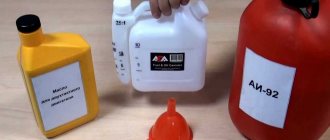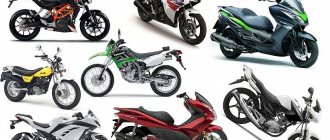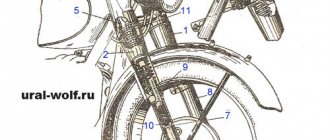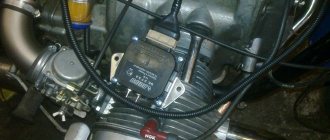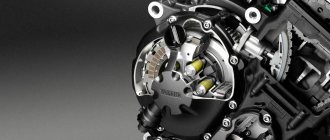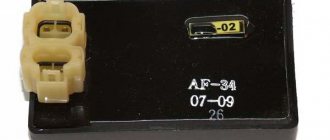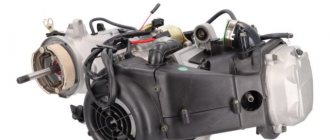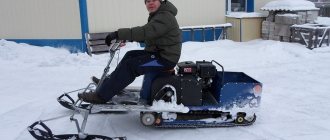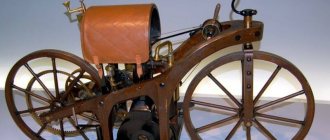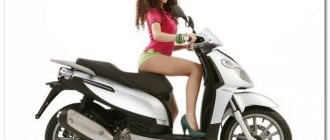Inexperienced people in the matter of motorcycle engines pay attention only to the maximum power, the so-called “horses”. They don’t really take into account the remaining parameters, and as a rule they will spread the myth that a motorcycle with less than 100 hp. With. rides poorly, etc.
Before making a purchase, we recommend that you decide what you want from a two-wheeled friend, the terrain of use and the specific purposes of the purchase.
Today we will talk about the types of engines in motorcycles.
Arrangement of cylinders in modern motorcycle engines:
- A - single-cylinder two-stroke;
- B - single-cylinder four-stroke;
- B - two-stroke in-line with a transverse crankshaft;
- G - four-stroke in-line with a transverse crankshaft;
- D - four-stroke V-shaped with a longitudinal crankshaft;
- E - four-stroke V-shaped with a transverse crankshaft;
- Ж - four-stroke in-line with a transverse crankshaft;
- Z - two-stroke three-cylinder L-shaped with a transverse crankshaft;
- I - four-stroke two-cylinder with opposed cylinder arrangement;
- K - four-stroke two-cylinder with opposed cylinder arrangement.
The rarest engines are diesel engines; such equipment is very rare. Every year electric motors are becoming more and more common, everything is clear here, the world does not stand still. And the most common engines for motorcycles are with gasoline injection.
Gasoline internal combustion engines can be 2-stroke or 4-stroke. The first option is common in technology with a small number of cubes, since they have a simple structure and an excellent proportion of weight to power. This allows the engines to be in high demand among scooters, dirt bikes and touring applications. Civilian motorcycles with a 2-stroke engine are practically not produced. Such motorcycles can be considered for your purchase if you have no previous experience of traveling on such vehicles or have little experience. Good for learning to drive.
The most common internal combustion engines are 4-stroke (99% of modern models). They are much more modern, with a more complex design, they emit less harmful waste into the air and consume less fuel. Such engines are simpler and more reliable in maintenance; regular oil changes are enough for trouble-free operation for thousands of km.
In the world of motorcycles, there are a huge number of variations in engine layout, unlike in the automotive industry. But the question of choice often comes down to the financial factor, so how to choose the necessary heart of the motorcycle? Below we will provide you with detailed information for your considerations.
Motorcycle engine power
Torque is the product of the length of the arm and the force acting on it (meas. N*m). Power is the product of torque and angular velocity, in other words, the amount of work done at a certain speed (measured in hp).
The torque of a motorcycle engine depends on many factors, such as the radius of the crankshaft, piston area, internal cylindrical pressure, etc. And power depends on engine speed.
To obtain a powerful and torquey engine, large pistons must be driven very quickly to rotate the long arms of the crankshaft, but these are interchangeable things. It is much easier to spin smaller pistons to huge speeds, since they have a shorter stroke.
Motorcycle selection options
Power
This parameter varies from 6 to 160 hp. The more powerful the device, the greater the speed it can develop in a straight line or drive up a steep hill. Power is also needed to quickly gain speed when you need to quickly move away or overtake another vehicle on a limited section of the road.
If there is not enough power, then you have to rev up the engine for a long time and wait for a sufficient length of free oncoming lane to pass the car in front. At traffic lights, this will promise delay in movement, which will be used by more powerful cars and wedged ahead.
Therefore, the following recommendations are available:
1. For sports on sand, high performance is not required and a bike with a power of 6-10 hp is suitable.
2. Everyday quiet trips to work will be easy with a 10-12 hp engine.
3. If time is a priority, then motorcycles with 20-30 hp will be indispensable in urban areas.
4. For long-distance cruise trips, choose 60-80 hp.
5. Fans of high speeds on sports models should look for engines with an indicator of 100-160 hp.
Engine capacity
The second parameter that affects acceleration and traction is the volume of all cylinders of the power unit. It ranges from 80 to 1800 cm3. The larger the internal engine compartments, the higher the power.
1. For quiet movement around the city, a volume of 80-125 cm3 is enough.
2. Fishing trips or other difficult conditions can be easily overcome with an indicator of 150-250 cm3.
3. Energetic driving through a busy city is convenient with an indicator of 320 cm3.
4. Road travel is carried out on models from 600 cm3, and sports bikes are equipped with a volume from 800 to 1300 cm3.
engine's type
The motorcycle is equipped with various power units and according to their type:
1. 2-stroke engines have a simple structure and are easier to repair. They have high power, which is suitable for trips to the village, fishing or hunting. It is convenient to cover short distances in the city or on the highway.
2. 4-stroke units have stable, even traction and are better suited for long highway trips.
3. Electric motors are gaining increasing popularity due to their efficiency and noiselessness, as well as environmentally friendly operation. They allow you to travel about 50 km, after which several hours of recharging are required.
Maximum speed
This parameter ranges from 90 to 300 km/h. It is important to take this into account when planning the time to cover a certain route.
1. Now many series of motorcycles are equipped with low-power engines for high fuel economy, which allows them to be used only in urban areas for short trips. Their maximum limit is 90-100 km/h, but this is quite enough, because the speed limit is 60 km/h.
2. If you regularly go out on the highway (short trips, business in a neighboring city, visiting relatives), you can look for models with an indicator of 130-180 km/h. This will allow you to move at a cruising speed of 110-130 and quickly overtake if necessary.
3. Those who plan to get on the autobahn need motorcycles with the ability to accelerate to 260-300 km/h, which will allow you not to feel discomfort and will significantly save time.
Cooling type
The longer the engine runs, the hotter it gets. If it is not cooled, the internal metal elements will expand and jam. This will lead to costly major repairs. The longer the trips, the more important the type of cooling is.
1. For use inside the city or in off-road conditions (jumping, sand), air cooling of the power unit is suitable.
2. For traveling at high speeds (frequent trips at speeds of 200 km/h and above), you should look for engines with oil cooling.
Fuel supply
The fuel mixture can be injected into the engine cylinders in two ways:
1. Through the carburetor. This is a simple unit with channels that is easy to clean if clogged. It provides high power, but is not always stable in operation. The flow needs to be adjusted periodically. This is the best option for the city, fishing or hobby.
2. Injector. Gives a more finely dispersed injection, which significantly saves consumption and stabilizes the flow. Thanks to the injector, the power unit produces the required speed for a long time without jerking or “choking.” This type of injection is more required on long highway journeys.
Transmission
1. A manual transmission allows you to create drive and last longer at lower speeds for a sharper start and acceleration. This is suitable for city driving and those who like to save time. But here you need to constantly monitor the operation of the motor and make switches.
2. The automatic version does not require driver participation and the automation independently controls the speed, increasing or decreasing the speed. This is convenient for long distances with ups and downs, where the driver only has to keep an eye on the road. But you can forget about sharp starts here. Such a system also consumes more fuel.
Brakes
To feel safe on a motorcycle, it is important to have good brakes that work effectively in all conditions.
By type they are as follows:
1. Mechanical disc ones - they work by pressing a handle on the steering wheel, from which a cable tightens the pads around the disc on the wheel. Suitable for quiet trips around the city.
2. Hydraulic disc ones - they function in the same way as those described above, but the degree of pressure is much higher, since it is regulated not by hand force, but by a hydraulic drive. This is a good option for the highway.
3. Drum type - have an internal system in the drum, where semicircular linings are moved apart by springs towards the walls and slow down the rotation. Their operation is not affected by rain and snow, as well as wet tall grass, which makes them optimal for both the city and for fishing and hunting.
Windshield height
A small glass panel protects the driver's face from midges and small debris. Thanks to this part of the motorcycle, when moving, an air flow is created that rises up without touching a person and carries away small particles. Otherwise, this would lead to rapid contamination of the helmet.
1. For the everyday route to and from work, with a good helmet, a windshield is not required or may be minimal for design purposes.
2. Long journeys, on the contrary, require a high transparent barrier that would completely cover the driver.
3. Racing models of any height lose their effectiveness at speeds above 260 km/h, but it is important that the user’s helmet is at least half covered with this element.
Suspension
The suspension is responsible for the smooth ride. Without it, there would be much fewer motorcycle enthusiasts due to frequent impacts on the saddle during bumps and holes.
There are several types of suspension:
1. Telescopic - has cylinders located on the fork. They compensate for road unevenness by retracting or protruding their working part so that the position of the body itself remains constant. This is more suitable for smooth asphalt and speed bumps.
2. Monoshock absorber - the pendulum system is attached to the frame at the rear and operates in an almost horizontal position. This gives greater possibilities for wheel travel (up to 20 cm) on uneven surfaces, and makes it suitable for hurdles and jumps.
3. Struts with springs - this is another type of suspension located at the rear. This design is more rigid and suitable for smooth roads and highways.
Battery capacity
For electric models, an important parameter is the battery capacity. Charging time and travel range depend on this. Values can be from 15 to 25 A/h. Which is proportional to the distance of 40-70 km. Charging downtime varies from 4 to 6 hours.
When choosing such a motorcycle, you should carefully calculate your route to make sure that the capacity will be enough to reach your final destination and there will be time and opportunity to recharge it.
Weight
The weight of a motorcycle can be from 70 to 350 kg. This is influenced by its equipment, engine size, tank capacity, etc.
The more weight, the more stable the device is on the track at high speeds (the nose will not lift up). But the impressive mass adds difficulties when maintaining balance at traffic lights and slow turns.
1. For jumping and tricks, you need light models weighing 70-80 kg.
2. Getting to work or school in a busy city is easier on a light motorcycle weighing 90-110 kg.
3. Long highway trips require a mass of 300 kg.
4. High speed on the autobahn is well tolerated with a weight of at least 200 kg.
Seat height
In a motorcycle, in addition to maneuverability, driver comfort is also important. Staying in an uncomfortable position for a long time only causes pain and prevents you from enjoying the trip. This is affected by the height of the saddle.
1. To jump from springboards you need very tall models of 960 mm.
2. On the track, a vertical landing on a bike of 700-800 mm, or lower (500-600 mm), is comfortable, provided that the wheelbase is long and the footrests are located far in front.
3. For sports motorcycles, a recumbent seat is provided, where the legs are placed slightly behind. Here the height can vary from 500 to 700 mm.
Fuel tank volume
This figure on various motorbikes can range from 3 to 23 liters. Its capacity affects the travel range without refueling, as well as the total weight of the vehicle.
1. For jumping, you need small reserves, since training takes place nearby, and large weight interferes with tricks. Here choose a capacity of 3.5-4 liters.
2. For inner city use, where there are many opportunities to refuel, choose light motorcycles with a 6-8 liter tank.
3. Periodic fishing trips or between cities require a sufficient supply of fuel, which is 11-14 liters.
4. To travel and conquer many hundreds of kilometers, a volume of 20-23 liters is required.
Length
The motorcycle can have length dimensions from 1600 mm to 2600 mm. This affects maneuverability. The larger the base, the wider the turning circle. This is hardly noticeable on the highway, but comes in handy in a busy city where you need to get out of a place jammed with cars.
Luggage compartment size
This criterion should be taken into account if you have to transport any items.
1. Take a small bag or briefcase with you to work, which does not require a trunk.
2. Fishing and hunting involve transporting gear and you need space under the seat for equipment. A side bag wouldn't hurt here either.
3. Long journeys always involve a certain amount of luggage, and such motorcycles need two side compartments and one rear compartment.
Wheel size
The diameter of motorcycle wheels ranges from R12 to 18 inches. This value affects the speed - with the same number of revolutions, wheels with a larger diameter will travel further, which means the movement will be faster. This also affects overcoming small holes. They are not that noticeable.
1. For the city, where speed plays a secondary role and there is good coverage, R12-14 wheels are suitable.
2. Cruise tours on an iron horse are best carried out with a diameter of R15-16.
3. Autobahn racing will require a maximum of R17-18.
V-twin
There are two types of V-twin engines:
- "Aerial" . They are installed in Harleys and other cruisers because of the aesthetics of the engine itself. Pros: very good torque at low revs, simple design and beautiful appearance. Cons: vibration, poor cooling of the rear cylinder, small operating range.
- "Liquid" . Motorcycle manufacturers from Italy love this type of engine, as they know how to achieve good performance characteristics from them. Pros: high power and torque, the operating range is quite wide, the design is narrow in size. Cons: difficult to maintain engine with expensive repairs.
Which motorcycle to choose
1. For stunts, a young man will need a cross-country off-road motorcycle with a power unit capacity of 200 cm3, 4 strokes for 18 hp, carburetor type injection, mechanical transmission, seat height 980 mm, weight 120 kg, front disc and rear drum brakes , wheels on R18, air cooling.
2. To work, study or fishing you can drive a device with a volume of 125 cm3, power of 11 hp, maximum speed of 100 km/h, carburetor feed, manual transmission, air cooling, total length 2040 mm, R15 wheels, hydraulic disc front brakes and rear drum brakes, telescopic suspension, 6-liter tank.
3. Travel within the country or abroad is carried out on a cruise tourist model with an engine capacity of 1200 cm3, a power of 150 hp, a 22 liter tank, injection injection, an automatic transmission, hydraulic disc brakes, a saddle height of 760 mm, and oil cooling. , three luggage compartments, a high windshield, R17 wheels, weighing 350 kg.
4. Autobahn racing will require a sports version with a power unit capacity of 600 cm3, 131 hp, operating on 4 strokes, with a liquid cooling system, injection injection, manual transmission, telescopic forks in front and a monoshock absorber in the rear, R18 wheels, disc hydraulic brakes, a maximum speed of 260-300 km/h, a 14-liter tank and a total weight of 200 kg.
Opposite
A piston internal combustion engine with rows of cylinders positioned at an angle of 180 degrees relative to each other. Reaching the dead center of the opposing pistons occurs simultaneously (mirrored). Very similar to the V-twin engine, but the difference is in the degree of cylinder placement. Used by BMW and in our Urals and Dnieper. Pros: high torque, cylinders are well cooled, center of gravity is low. Cons: wide design and difficult to assemble (especially the gas distribution mechanism).
Our recommendation is to purchase original components. We cooperate with manufacturing plants Suzuki and Honda and supply contract spare parts that are tested by specialists. Write to our employees, they will help you choose the right part.
Honda Africa Twin Adventure Sports
You may accuse me of being biased, but I love this bike! The big plus of this motorcycle is the larger gas tank. Nobody wants to get stuck in the middle of a forest or field, when there are still kilometers to refuel, and the motorcycle is already running on gasoline fumes... The manufacturer thought that you could go very far, so they increased the tank to 24.8 liters!
For example, Honda Africa Twin AS A4L with an engine capacity of 1084 cc. cm.
The engine is four-stroke, two-cylinder in-line, eight-valve, liquid-cooled. It comes with a multi-plate slipper clutch and a six-speed gearbox.
The brake system is hydraulic. ABS with off-road and on-road modes is provided.
The front brake features two 310mm diameter floating discs with an aluminum hub, metal plated pads and four-piston radial calipers.
The rear wheel has one disc with a diameter of 256 mm with a two-piston caliper. There are also metallized pads here.
The weight of the motorcycle when equipped is 238 kilograms. The maximum permitted weight stated by the manufacturer is 456 kilograms.
As standard, users have access to cruise control, automatic turn signal off, heated grips and a 12-volt power outlet, rollover and wheel lift control systems, as well as an emergency braking warning system. But the quickshifter is an optional offer. There is also a wireless Bluetooth connection, a color touch screen and an LCD panel.
To adapt to any road conditions, the manufacturer has thought out seven levels of adjustment and driving modes, such as city, gravel, touring, off-road and two custom.
What else? In addition to the larger tank, you will be pleased with the high adjustable windshield, tubeless tires, spoked wheels, engine protection and roll bars. Beauty, not a bike!
By the way, this pleasure costs almost one million four hundred thousand rubles. Starter set, there are modifications and other versions. Users especially praise the CRF1100L Africa Twin Adventure Sport ES.
Choppers
Heavy and powerful motorcycles that are replete with chrome parts. They are easy to recognize by their soft suspension and stepped saddle, drop tank and side saddlebags, narrow front and wide rear wheels. Necessary for driving far outside the city, for example, on intercity highways. You can choose expensive exclusive and cheaper chopper models.
Enduro
A subclass of motocross motorcycles. They are quite maneuverable and designed for off-road travel. Motorcycles of this class weigh little, have a two-cylinder engine and a quiet engine sound. It is worth noting that these motorcycles are powerful, they do not stop in front of obstacles on the roads.
There are three subclasses of motorcycles:
- soft enduro;
- hard enduro;
- enduro tourist.
Sports tours
Touring motorcycles will be indispensable for long-distance travel. They weigh a lot, so they easily resist gusts of wind. The driver of a sports-touring class motorcycle sits on a comfortable seat, which avoids fatigue.
Among the advantages, it is worth noting the installation of an additional fuel tank, evenly spaced footrests and steering wheel, and a powerful engine. The disadvantages include the high cost of the vehicle and low maneuverability.

